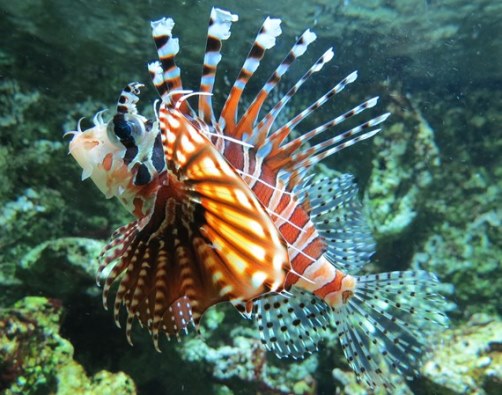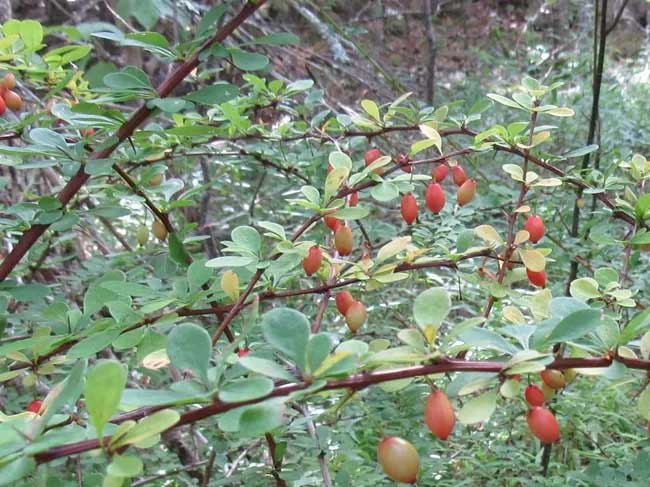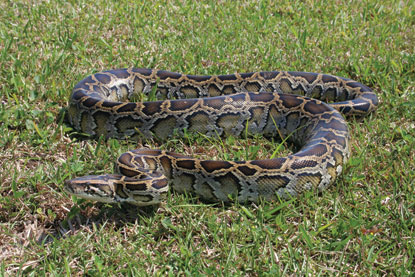Key Concepts
A species translocated from one region or continent to another outside its normal range, particularly when the translocation is the result of human activity (intentional or otherwise). Many thousands of species, including animals, plants, fungi, bacteria, and viruses, have been transported to areas outside their native ranges and have successfully established new populations there. If one of these introduced species then causes significant negative ecological, economic, or human-health impacts, it is categorized as an invasive species (also termed a nonnative or nonindigenous species) [Fig. 1]. See also: Biogeography; Ecological community; Ecology; Invasion ecology; Invasive forest species; Invasive lionfish; Population dispersal; Population dispersion; Population ecology; Population viability

The movement of species around the globe is not a new phenomenon, but human intervention has drastically increased the rate of movement, the distances that organisms can travel, and the types of species that are now transported around the globe. Invasive species are accidentally or intentionally introduced to new areas via many routes, including the horticultural trade, agriculture, aquaculture, agroforestry, the game animal trade, the pet trade, ship ballast, fishing bait, transport of untreated wood, and mud stuck to boots or tires. They also can be introduced as food items.
Impacts
The economic cost of invasive species in terms of property values, public utility operations, agricultural productivity, native fisheries, tourism, and control of invasive species populations is considerable. A 2021 study estimated that invasive species have cost North America over $26 billion since 2010. Worldwide, the cost is estimated to be more than $1.3 trillion over the past 50 years. For example, invasive wasps, fish, and trees have cost South Africa about 6.5 billion rand (approximately US$450 million) and are responsible for nearly one-fourth of its biodiversity loss. Making matters worse, invasive trees are threatening South Africa's critical water supply. See also: Biodiversity
Invasive species can also increase public health risks. In the northeastern United States, for instance, invasive Japanese barberry bushes (Berberis thunbergii) (Fig. 2)—a hearty, drought-tolerant species that is popular as an ornamental plant—change the soil chemistry and push out native species. These invasive bushes also attract blacklegged ticks (Ixodes scapularis, also known as deer ticks), which are responsible for transmitting Lyme disease to humans. The plants further provide nesting areas for white-footed mice (Peromyscus leucopus), which also host blacklegged ticks and serve as primary sources for larval ticks' first blood meal. See also: Lyme disease; Soil chemistry; Tick virus diseases

Invasives can impact native species through predation, disease, herbivory, competition for resources, and hybridization, resulting in genetic swamping of the native species. Entire ecosystems are affected by invasives that alter fire regimes, cause nitrogen enrichment, and remove native foundation species. The following case studies demonstrate both the diversity of invasive species and the range of effects that they can have on native species and ecosystems. See also: Ecological competition; Ecosystem; Eutrophication
Examples
Predatory invasives
Free-roaming cats
Invasive cats (Felis catus) inhabit all continents except Antarctica, are intensive breeders, and have been labeled the most dangerous of any introduced carnivore. Cats can impact native species by outcompeting for resources, transmitting disease, and usurping habitat; but the most direct way that cats impact wildlife is through predation. Many runaway cats, stowaway cats, and cats that have been intentionally released to control rodents have established feral populations—that is, these animals are fully independent of people. Feral cat populations have the potential to decimate populations of other native small mammals, as well as birds, reptiles, amphibians, fish, and invertebrates such as butterflies and dragonflies. In every major country, feral cats kill at least hundreds of millions of birds each year by preying on them. In the United States along, this number reaches into the billions. See also: Cat; Predator-prey interactions
On islands, the threat is even more severe for native species that lack defenses against feline predators. For example, the cat of a lighthouse keeper was solely responsible for the extinction of the Stephens Island wren (Xenicus lyalli)—the only flightless songbird in the world—in 1894. Twelve additional native bird species were extirpated from this island by other cats within a few years. Feral cat populations have been controlled successfully with the introduction of feline-specific viruses or toxins, followed by hunting and trapping once the population size is reduced. In one such successful program, the removal of cats from Long Cay, an island in the Bahamas, resulted in the recovery of the highly endangered iguana (Cyclura carinata). See also: Extinction; Island biogeography
The consequences of removing cats and other invasive species can be much more complex than anticipated, however. Consider the case of the 1818 cat introduction on Macquarie Island, Australia. Initially, the introduced cats had little effect on the abundant Macquarie Island parakeet (Cyanoramphus erythrotis). When rabbits (Oryctolagus cuniculus) were introduced into the island's animal community in 1879, the rabbits became a year-round food supply for the cats, resulting in rapid growth of the cat population. Ultimately, the large cat population hunted the endemic parakeet to extinction by around 1890. Decades later, in the 1960s, it became clear that the rabbits, which had by then overrun the island, were destroying the maritime grasses, and thus scientists in Australia introduced the Myxoma virus as a biocontrol for the rabbit population. Rabbit populations became much lower by the 1970s, with the final rabbits being immune to the virus; this led the cats to switch to eating seabirds. To protect the seabirds, a cat eradication effort began in 1985, and the final cats were removed from the island in 2001. At that point, the remaining rabbits (that is, those that survived the virus and the cats) began to reproduce rapidly, and once again began to devastate the island's unique plant communities, transforming them into bare ground or grazed lawns. See also: Lagomorpha
Brown tree snakes and Burmese pythons
The brown tree snake (Boiga irregularis) was accidentally introduced to Guam after World War II, probably through the undercarriage of military aircraft. By the early 1980s, there were an estimated two million brown tree snakes in Guam, as the reptiles had ample food supplies, no known diseases or parasites, and very few predators on the island. The brown tree snake has since devastated Guam's native fauna, including birds, bats, geckoes, and skinks. Because these animals did not coevolve with the brown tree snake or similar reptiles, they had few defenses against such an efficient, nocturnal, arboreal predator. Although Guam's population of brown tree snakes has since declined, the loss of bird and bat species has had cascading effects across the entire island because those species played important roles in pollinating flowers, dispersing seeds, and controlling insect populations. Many other invasive species, including introduced rats, pigs, deer, birds, and skinks, have become established on Guam as well, further affecting native ecosystems. Old-growth forests on the island are no longer regenerating, and the fate of other native species is unclear. In addition to their effect on native species, brown tree snakes also directly impact economic costs when the snakes crawl into and short out electrical transmission systems, resulting in power outages. Interdiction (efforts to prevent dispersal of snakes from Guam to other islands) has been mostly successful, and the U.S Department of the Interior spends millions of dollars each year on suppression and control of brown tree snakes in Guam. See also: Endangered species; Squamata
Invasions of nonnative snake species continue to occur around the globe. For instance, Burmese pythons (Python molurus bivittatus) (Fig. 3)—a popular pet because of their unusual color pattern—have been an invader in Florida in the United States since the 1990s. These snakes prey on a variety of animals, including threatened wood storks (Mycteria americana) and endangered Key Largo woodrats (Neotoma floridana smalli), as well as other species that are also of conservation concern: white ibis, limpkins, and round-tailed muskrats. In South Florida, Burmese pythons are particularly concerning because the subtropical climate and vast undisturbed Everglades habitat allow these invaders to breed and thrive. The pythons now occupy thousands of square kilometers in South Florida, and their population size is estimated to number in the thousands. Although cold temperatures may eventually limit the pythons' spread northward, it is unclear whether control measures will be able to prevent them from invading other suitable habitats nearby, such as the ecologically vulnerable Florida Keys. See also: Effects of invasive Burmese pythons in Everglades National Park

Forest invaders
Chestnut blight
Chestnut blight (Cryphonectria parasitica) is an invasive fungus from Asia that first arrived in North America on infected Japanese chestnut trees in the late 1800s. The fungus was first detected on American chestnut trees (Castanea dentata) in 1904 at the New York Zoological Park in the United States. As the trees lacked any resistance or tolerance to the disease, chestnut blight rapidly spread throughout the deciduous forests of the eastern region of the country. When the fungus spores invade chestnut trees through any small break in the bark, the fungal mycelium—or vegetative body—grows throughout the vascular tissue of the tree, killing the tissue and stopping the transport of water and nutrients. Billions of American chestnut trees were lost from the forests of the eastern United States and were replaced by other hardwood species, primarily oak trees. The chestnut was once a dominant forest species, amounting to 25% of the trees in some areas of the United States. These trees produced huge quantities of nuts every year, so the loss of the chestnut had a negative impact on other species that depended on those nuts for food, including bears, deer, elk, squirrels, raccoons, and turkeys, as well as the people who harvested the nuts. Chestnut trees now exist only as small understory tree sprouts that grow from the old stumps. These sprouts eventually succumb again to the blight, and new sprouts emerge. Reproduction by seed is absent. At some point, these old stumps will lose their vigor and the sprouts will die out. Several organizations are working to develop blight-resistant strains of the American chestnut, but it may never be able to return as a dominant tree species in the forests of the eastern United States. See also: Chestnut; Fungi; Restoration of the American chestnut tree
Emerald ash borer
The emerald ash borer (Agrilus planipennis) (Fig. 4, left) is an invasive beetle introduced from Asia that is decimating native ash trees (Fraxinus spp.) in North America. This insect was first discovered in 2002, but it had probably been introduced about a decade or more earlier from Asia into the Detroit area of Michigan, in the United States, through untreated ash wood used in crates or packing materials. The emerald ash borer is now found in at least 35 states and five Canadian provinces. The adults nibble on ash foliage and cause little damage; but when the larvae feed on the thin cambium layer under the tree bark, their feeding galleries disrupt the flow of water and nutrients in the tree (Fig. 4, right). The beetles remain in the bark and wood as larvae and pupae. Then, when the adults emerge, they may disperse up to 0.8 km (0.5 mi) away. The emerald ash borer also spreads through infected nursery trees that are shipped and through the transport of firewood. Efforts are being made to identify early infestations to limit the spread of the ash borer, but hundreds of millions of trees have already been killed. To slow the beetles' spread, The U.S. Department of Agriculture (USDA) is using tiny stingless wasps as a biological control agent. These wasps are harmless to humans, but they are highly effective at killing the insect's larvae and eggs. However, according to the USDA, the rapid expansion of the emerald ash borer infestation across a wide range of climate zones suggests that this invasive insect will continue spreading throughout North America. See also: Ash; Biological insect control; Coleoptera
![[left]: close up of an iridescent beetle with large black eyes and metallic green body with long amber wings on a rock substrate; [right]: photo of an ash tree trunk with a rectangular strip cut away from its bark, revealing tunnels and trails within the tissue below](/media/EST/media/350480FG0040.png)
Ecosystem transformers
Cheatgrass
Cheatgrass (Bromus tectorum) has invaded arid regions worldwide after accidental introduction as a seed contaminant in cereal crops. Between 1890 and 1935, cheatgrass transformed the Intermountain West region of the United States (that is, the area between the Rocky Mountains to the east and the Pacific mountain ranges to the west) into a virtual monoculture. Native to Europe and Eastern Asia, cheatgrass is now the dominant plant across an estimated 20–28 million hectares (50–70 million acres) in the United States. Cheatgrass uses a large proportion of soil moisture, making the subsequent establishment of more desirable plant species difficult. Making matters worse, cheatgrass is an annual that dies in the summer, creating a blanket of highly combustible fuel across the landscape, unlike perennial native grasses. Cheatgrass also dries out much earlier than native vegetation, causing the historic fire season to lengthen. Furthermore, these plants grow very close together, creating a continuous fire base. The resulting frequent wildfires cover hundreds of thousands of hectares in the United States and move quickly across the landscape, totally consuming all aboveground plant material. The loss of the native shrub community and other perennial plant species has destroyed habitats for the endangered sage grouse (Centrocercus urophasianus), as well as many other native wildlife species; this creates even more cheatgrass-dominated rangeland. See also: Fire and disturbance ecology; Grass crop
Earthworms
During the Pleistocene epoch, from about 2.6 million years ago to 10,000 years ago, glaciers covered much of eastern North America. When the glaciers retreated, earthworms were nowhere to be found. Over the past few centuries, the use of soil as ballast, the relocation of landfills, the nursery trade, reforestation projects, and the release of unused bait have resulted in the introduction of well over 100 different earthworm species. When earthworms invade, the leaf litter layer vanishes as the worms mix surface organic matter into underlying mineral soil. The loss of the litter layer shifts the food web relationships of litter-dwelling and litter-feeding organisms, altering their species abundance and community composition. Declines in native ferns, woodland flowers, and tree species, such as sugar maple, have been linked to the presence of invasive earthworms in the United States, whereas the growth of invasive plants, such as European barberry (Berberis vulgaris), stiltgrass (Microstegium vimineum), and garlic mustard (Alliaria petiolata), is facilitated. In addition to redistributing soil organic matter, earthworms also alter soil porosity and soil structure, increase the rate of nutrient cycling, create higher levels of nitrogen in the soil, raise the soil pH, and increase the rate of litter decomposition. These transformations, coupled with excessive deer herbivory and pressure from invasive plants, have a profound influence on the regeneration of deciduous forests in the eastern United States. See also: Forest ecosystem; Oligochaeta; Pleistocene; Soil ecology
Future conservation
As seen in these examples, invasive species can have devastating effects on native species and ecosystems. The challenge is in deciding how to respond to these invasions. Some conservationists see the task of removing invaders as a very expensive and nearly impossible goal, and they argue that invasives are here to stay. Preserving native biodiversity within these novel ecosystems is seen as a more realistic and reachable goal than trying to restore the original ecosystem. These conservationists also see great value in preserving ecosystem function, regardless of the species composition. Others disagree and point to the numerous examples of successful eradication and control of invasive species. These conservationists argue that the threat to global biodiversity is too great to not continue the fight against invasives. Conservationists on both sides of this issue agree that the best solution is to prevent further invasions and, whenever possible, to eradicate invasives in areas before they become fully established. See also: Conservation of species; Restoration ecology





